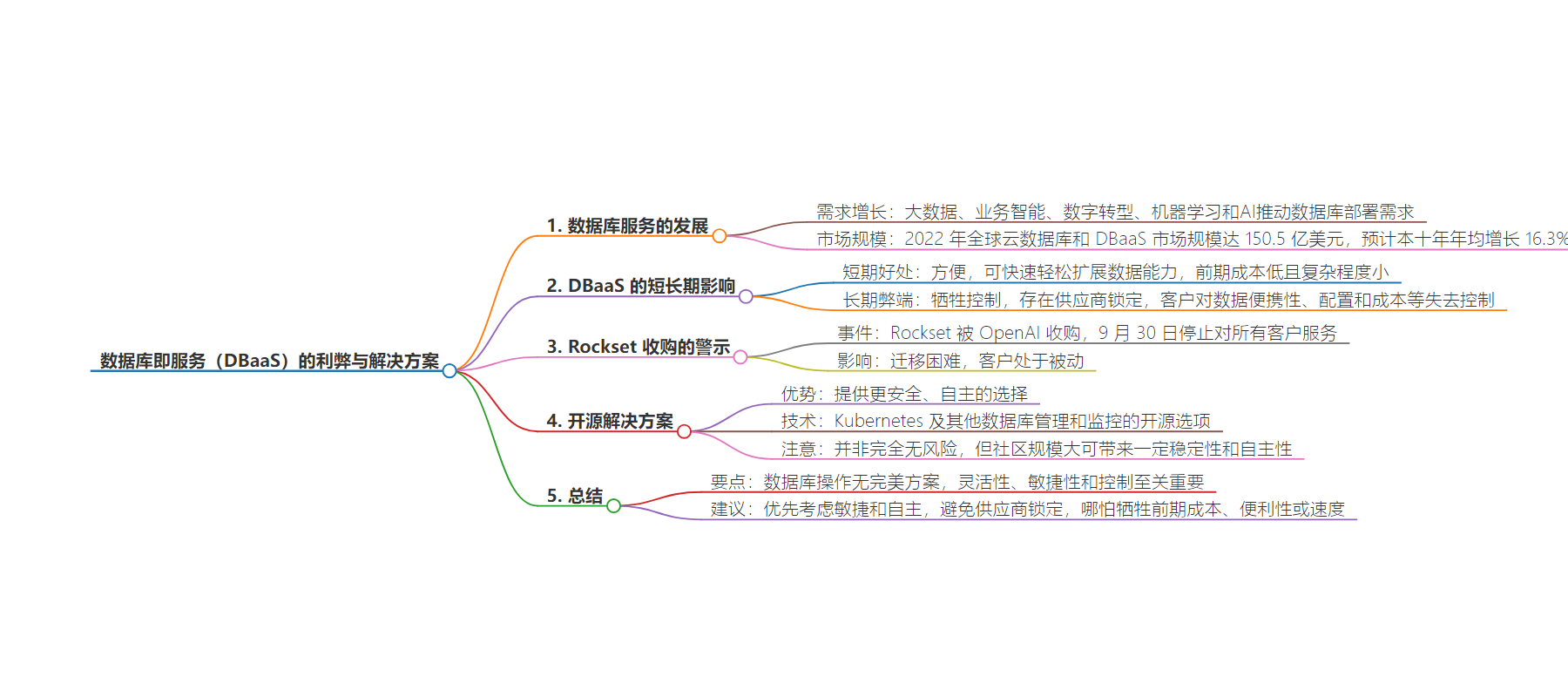包阅导读总结
1. 关键词:Database as a Service、Convenience、Cost、Open Source、Vendor Lock-In
2. 总结:文章探讨了数据库即服务(DBaaS)的发展、短期优势及长期权衡,指出其牺牲了控制,以 Rockset 被收购为例,强调开源是更安全自主的解决方案,同时也指出技术选择要权衡,组织应优先考虑敏捷和自主。
3. 主要内容:
– 数据库领域发展迅速,DBaaS 市场规模增长
– DBaaS 短期优势在于便捷,可快速轻松扩展数据能力,前期成本低,但存在长期权衡
– 选择公共专有 DBaaS 平台会牺牲控制,易形成供应商锁定
– Rockset 被收购致服务终止,用户迁移困难,凸显 DBaaS 风险
– 开源是应对此类问题的途径,如 Kubernetes 等,但也非完全稳定
– 组织应优先考虑灵活性、敏捷性和控制,避免供应商锁定
思维导图:
文章地址:https://thenewstack.io/the-hidden-cost-of-dbaass-convenience/
文章来源:thenewstack.io
作者:Ann Schlemmer
发布时间:2024/8/12 20:22
语言:英文
总字数:953字
预计阅读时间:4分钟
评分:87分
标签:DBaaS,云数据库,开源,供应商锁定,Kubernetes
以下为原文内容
本内容来源于用户推荐转载,旨在分享知识与观点,如有侵权请联系删除 联系邮箱 media@ilingban.com
It’s a refrain we’ve been hearing regularly for nearly a decade now. First, it was the age of Big Data and business intelligence driving the ever-accelerating demand for enterprise database deployments. Then came the roaring call for digital transformation and cloud native development. Now the twin-jet engines of machine learning and AI have been bolted onto this Frankensteinian engine.
As interest in these technologies from both young startups and established businesses continues to surge, something of an arms race is starting to take shape in the database space. As you have likely heard, in today’s information age, “data is the new oil.” And to make that data accessible, more and more organizations are turning to fully managed cloud-based offerings — commonly referred to as database as a service (DBaaS) — to get the job done.
As of 2022, the global cloud database and DBaaS market size was valued at $15.05 billion; over the course of this decade, it is expected to grow at a blistering pace of 16.3% annually (CAGR) — outpacing the expected growth rate of the data and analytics market overall by over three percentage points.
Short-Term Benefits, Long-Term Trade-Offs
There are good reasons why these services make up a growing portion of the overall market; however, at their core, most boil down to one overarching advantage: convenience.
With public DBaaS services, organizations can scale their data capabilities quickly and effortlessly. They require little in-house expertise or energy, as the public DBaaS provider automates away many of the complexities of database deployment and administration. To help entice customers, these vendors also often keep upfront costs low and complications to a minimum.
However, organizations often unwittingly make tradeoffs when opting for public, proprietary DBaaS platforms, and the No. 1 compromise is the sacrifice of control. These services often cultivate vendor lock-in, making it so their customers have no readily available recourse to maintain control over things like data portability, database configurations and costs.
And once the customer’s data operations are sequestered in the vendor’s “walled garden,” that customer can quickly find themselves at the vendor’s mercy.
Rockset’s Acquisition Tells Cautionary Tale
At the end of June, cloud DBaaS provider Rockset announced it was being acquired by OpenAI. Typically cause for celebration for those in the startup community, this exit came with the unsavory announcement that Rockset would be ending service to all customers by September 30.
Even in the world of rug-pulls, a sub-three-month lead time for paying, contract-holding customers is egregiously short. What’s more, as lock-in is often the name of the game for these providers, portability, interoperability and integrations are usually at the bottom of their list of priorities. So, when something like this occurs, their customers’ migration process is likely to be cumbersome, to say the least.
While the next two months will be challenging for Rockset’s user base, there is light at the end of the tunnel for these organizations. Although the migration will likely be challenging, alternatives exist that could leave them better positioned to navigate the world of database operations in the long run.
Open Source Offers Safer, More Autonomous Solutions
Whether you’ve been cast off by Rockset’s recent acquisition or you’re simply considering your options for new database deployments, there is one pathway that is all but ensured to protect you against such curveballs: open source.
Today there’s an entire technical stack to consider when discussing database operations. However, at the deployment level, one of the most popular and well-supported open source models is Kubernetes. By 2022, over 60% of organizations had adopted Kubernetes in some capacity, making it one of the fastest-growing open source projects in history.
However, open source alternatives don’t begin and end with Kubernetes. Beyond deployment, there are also open source options for database management and monitoring available, even some that make DBaaS-level convenience possible.
Open Source Brings Stability, Autonomy
While open source is always preferable when it comes to control and autonomy, it’s important to note that it’s not a foolproof path to stability. As we’ve seen with projects and organizations such as Redis — which recently clawed back its open source license in favor of a proprietary model — there is still risk involved when investing significant elements of your stack to a single provider or project.
However, as with Kubernetes, when an open source project has a large enough community (or makes use of open source projects that do), then you have a certain degree of built-in stability, autonomy and self-determination that can’t be reproduced elsewhere.
Ultimately, there’s no perfect solution platform, or approach for deploying, managing and monitoring database operations. Each application, use case and organization has unique requirements, constraints and considerations — all of which have the potential to dramatically influence the best solutions for that organization.
However, three qualities that have become almost universally advantageous for all database operations are flexibility, agility and control. In a technological landscape increasingly defined solely by its state of permanent flux, it’s imperative that organizations develop operational stacks that allow quick, nimble pivoting and sacrifice as little autonomy as possible.
If your organization wishes to survive this age of continuous flux, you must prioritize agility and autonomy above all else — recognizing and resisting opportunities for vendor lock-in whenever possible. Even if it comes at the direct expense of upfront cost, convenience or speed.
While making sacrifices with a proprietary, public DBaaS offering may help give a leg up on your competition in the short run, it won’t take long before it transforms into the proverbial ball and chains holding you back.
YOUTUBE.COM/THENEWSTACK
Tech moves fast, don’t miss an episode. Subscribe to our YouTubechannel to stream all our podcasts, interviews, demos, and more.
